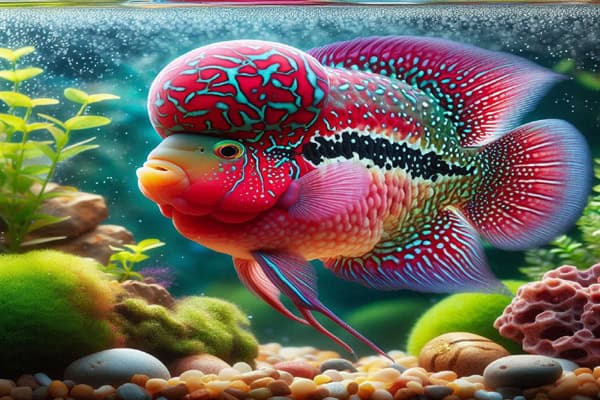
Flowerhorn Fish have known aquarium lover worldwide because of their unique appearance and distinctive behavior. With their bright colors and the prominent “kok” (a fleshy head bump), Flowerhorn Fish are the showpieces of any aquarium. Their hybrid nature and deep cultural background add to their enigma.
You should be aware of Flowerhorns, their origin, their needs for care, and how to maintain them in good health in your aquarium. If you are an experienced aquarist or if you are thinking of having Flowerhorns as a pet, Our detailed guide will clear all your doubts.
Table of Contents
What is Flowerhorn Fish?
A Flowerhorn fish is a widespread, man-made hybrid cichlid that has a distinguishing look and range of colors. Flowerhorns popularity as decorative fish, particularly in Thailand, Malaysia, and Taiwan, where they were cultivated based on their appearance and distinctive look. Flowerhorns can be bred in captivity, and their fry (young fish) are occasionally sold.
The Origins of Flowerhorn Fish
Flowerhorns are relatively new additions to the aquarium fish community, first appearing in the late 20th century. Flowerhorns are hybrids, crossed for purely ornamental purposes. Their special blend of species makes them look like they do, including their legendary kok on top of their heads.
The precise species that contributed to the Flowerhorn hybrid are controversial, but the majority of breeders have a consensus that the primary contributors are:
- Red Devil Cichlid (Amphilophus citrinellus)
- Trimac Cichlid (Cichlasoma trimaculatum)
- Midnight Cichlid (Cichlasoma spp.)
- Jaguar Cichlid (Parachromis managuensis)
These cichlids were chosen based on their coloration, hardiness, and breeding capability in captivity. Selective breeding methods have over time perfected the Flowerhorn’s appearance, and it’s now one of the most desired aquarium fish in the world..
What is Physical Characteristics of Flowerhorn Fish?
Flowerhorns are known for their large size and striking features. Here are some of the most notable physical characteristics:
- Size and Growth Patterns: Flowerhorns typically grow between 10-16 inches (25-40 cm) in length, with some individuals reaching even larger sizes under the right conditions.
- The Kok: One of the most defining features of the Flowerhorn is the kok—a large, fleshy bump that develops on the forehead as the fish matures. The size and prominence of the kok are often considered a sign of the fish’s health and genetic quality.
- Color Variations: Flowerhorns come in a wide range of colors, including red, orange, yellow, and even metallic shades like gold and blue. Some flowerhorns have speckled or marbled patterns, while others feature solid, intense colors.
- Shape and Fins: Flowerhorns have a deep, laterally compressed body with long, flowing fins. Their tails can be broad or pointed depending on the variety.
- Sexual Dimorphism: Males tend to have a more prominent kok, larger fins, and more vibrant colors than females. Females are typically smaller and have a less pronounced head bump.
You must known the Types of Flowerhorn Fish
The Flowerhorn species has evolved into a variety of types, each with unique characteristics. Here are some of the most popular types:
- Red Dragon Flowerhorn: Known for its striking red coloration and large kok, the Red Dragon is one of the most famous and prized Flowerhorn types.
- Golden Monkey: This variety features golden and yellow hues, with some individuals sporting deep, rich orange or red colors.
- Zhen Zhu: Often called the “Pearl Flowerhorn,” the Zhen Zhu is known for its pearlescent scales and well-developed kok.
- King Kamfa: A premium Flowerhorn type, the King Kamfa is prized for its striking appearance and aggressive personality.
- Kamfa: Slightly less expensive than the King Kamfa but still highly valued, the Kamfa has a strong presence in the aquarium world.
- Thai Silk: These Flowerhorns feature a softer, more translucent appearance, with colors ranging from light silver to blue and red.
Each type has its own unique charm, and their price often reflects the size and quality of their kok, coloration, and overall body structure.
Known the Flowerhorn Fish Behavior and Personality before buy
Flowerhorns are known to be bold and sometimes aggressive. They are also territorial and might be hostile to other fish, particularly smaller or intrusive fish. Here’s what you can anticipate in terms of their behavior:
- Aggression and Territoriality: Flowerhorns will establish and defend territories within the aquarium. They can become aggressive toward other fish, particularly if they feel their space is being invaded.
- Social Interactions: While Flowerhorns are often best kept alone, they can sometimes live with larger, similarly aggressive fish. Tankmates should be chosen carefully to avoid conflict.
- Personality: Flowerhorns are intelligent and interactive, often responding to their owners with curiosity. Some owners even train them to follow their fingers or perform simple tricks.
- Mating Behavior: During mating, Flowerhorns will exhibit heightened aggression, with the male defending the female. The pair will create a territory within the tank where they will lay eggs, usually on a flat surface.
What is the requirements to take care of Flowerhorn Fish
Maintaining Flowerhorns in good health involves knowing their particular care requirements. These are the tank setup, water quality, diet, and maintenance practices. Let’s discuss each of these in detail:
- Aquarium Setup: Flowerhorns need a big tank (at least 75 gallons), as they become very large. They also need sufficient swimming space and room to create their territories.
- Water Conditions: Flowerhorns prefer warm water (75-85°F or 24-29°C) and a pH level of 7.0 to 8.0. Daily water changes are required to ensure a healthy environment.
- Filtration: Because Flowerhorns are messy feeders, a good filtration system is required to keep the water quality high.
- Tankmates: As stated, Flowerhorns are aggressive and territorial. If you decide to keep them with other fish, use large, hardy species that can stand their ground.
What to Feeding my Flowerhorn Fish?
Flowerhorns are omnivores and appreciate a diverse diet. They require an even balance of protein foods and Chapter 6: Feeding Your Flowerhorn Fish
Best Diet for Flowerhorns
Flowerhorns are omnivores, but they have a strong preference for protein-rich foods to support their growth and vibrant coloration. Their diet should be balanced, providing a mix of animal protein, plant-based foods, and various essential nutrients. Here’s a breakdown of the best foods for them:
- High-Quality Pellets: A staple in the diet of Flowerhorns, high-quality fish pellets provide a balanced mix of proteins, vitamins, and minerals. Look for pellets specifically designed for cichlids or carnivorous fish.
- Live and Frozen Foods: Flowerhorns thrive on live or frozen foods like shrimp, bloodworms, brine shrimp, and earthworms. These foods help stimulate their natural hunting instincts and are rich in essential nutrients.
- Fresh Meats: Sometimes, you can feed fresh meats such as chopped beef heart or fish fillets to complete their protein levels. These are to be served in small portions since they can be fat-prone.
- Vegetation: Flowerhorns do not eat much plant-based foods, but sometimes you may serve greens like lettuce, spinach, and zucchini. They will aid in digestion and maintaining their diet stable.
Commercial Fish Food vs. Live Food
Although commercial pellets are convenient and effective to feed Flowerhorns, live foods are very valuable. Live food has numerous benefits:
- Stimulation of Natural Behavior: Live foods promote more natural hunt and foraging habits.
- Higher Nutritional Value: Live foods have higher nutritional value, especially in amino acids and fatty acids, which are important for proper growth and coloration.
Still, live foods can occasionally bring in parasites or bacteria, so it’s important to get them from trusted suppliers and quarantine them first before feeding.
Supplementing with Vegetation and Treats
Though not a mainstay of their diet, Flowerhorns appreciate sporadic supplementation with plant foods such as:
- Spinach: Vitamins and minerals.
- Peas: Digestive health.
- Cucumbers and Zucchini: Hydration and fiber.
Supplements such as krill, daphnia, or clams may also be added from time to time to supplement their diet and keep them stimulated.
Feeding Regimen and Portion Management
Flowerhorns have large appetites but can become obese and cause water quality issues if overfed. The following are some guidelines for when and what to feed:
- Young Flowerhorns: Feed 3-4 times a day, giving only as much as they’ll consume within 2-3 minutes.
- Adult Flowerhorns: After maturation, feed them 2-3 times a day.
- Portion Control: Underfeeding slightly is better than overfeeding. Monitor their body condition on a regular basis to prevent over-weighting.
Tips for Maintaining Healthy Growth
- Variety: Feeding a variety of foods ensures they get all the nutrients they need for healthy growth.
- High-Quality Food: Spend money on good-quality pellets and live foods to provide them with the best possible nutrition.
- Regular Feeding Times: Adhere to a routine feeding schedule to avoid stress and encourage good eating habits.
Must aware about Health and Disease Prevention
Flowerhorn Diseases
Flowerhorns are fairly robust fish but remain vulnerable to some of the following frequent diseases, especially when water quality is substandard. Some of the most common ailments include:
- Ich (White Spot Disease): Caused by a protozoan parasite, Ich leads to white spots on the fins and skin. It’s very contagious but can be treated with copper-based medications.
- Fin Rot: Usually caused by bacterial infection or poor water quality, fin rot causes fraying and color changes in the fins.
- Dropsy: A severe condition in which the fish’s body is swollen because it has retained fluids. It’s typically a sign of organ infection or failure.
- Bacterial Infections: These can lead to ulcers, lesions, or discoloration, and often stem from poor water conditions or physical injury.
Identifying Symptoms of Illness
It’s essential to monitor your Flowerhorn closely for any signs of illness. Symptoms to watch for include:
- Loss of appetite: Can indicate stress, disease, or water quality issues.
- Abnormal swimming behavior: A sick fish may swim erratically or remain near the surface or bottom of the tank.
- Color Fading: Fading of color in coloration commonly indicates poor health or an inner problem.
- Body Changes: Seek signs such as swelling, lesion, or damage to fins.
Preventative Care (Vaccines, Supplements, etc.)
Though there are no vaccines for Flowerhorns, preventative care involves:
- Stable Water Parameters: Periodic water tests for pH, ammonia, nitrate, and hardness are crucial.
- Supplements: Supplementing with supplements such as garlic extract will enhance immunity, whereas vitamins A and D will help maintain skin color and health.
Proper Quarantine Procedures
When adding new fish to your aquarium, quarantining them for a period of at least 2 weeks is important. This provides enough time to observe for any form of illness and avoids possible disease transmission to your main tank.
Steps to quarantine new fish
- Separate Tank: Create a quarantine tank with minimal equipment.
- Observation: Monitor their behavior and physical health.
- Treatment: Treat the fish in the quarantine tank if you observe any symptoms of sickness before adding them to the main aquarium.
Regular Water Changes and Maintenance
Flowerhorns are prone to poor water quality. Regular water changes are essential to ensuring a healthy environment.
- Water Changes: Replace 25-30% of the water every 1-2 weeks to avoid the accumulation of toxins such as ammonia and nitrate.
- Tank Cleaning: Clean the tank decoration, substrate, and filter periodically to prevent the buildup of waste.
Breeding Flowerhorn Fish: Tips and Techniques
The Basics of Breeding Flowerhorns
Flowerhorns are not hard to breed once you possess a male and female pair. They are mouthbrooders; the female lays eggs on a flat surface and the male fertilizes them. Upon fertilization, the female can transfer the eggs to her mouth for protection before they hatch.
Tank Setup for Breeding
- Size: The breeding tank must be at least 55 gallons to provide the pair with sufficient space.
- Water Parameters: Maintain the water warm (80-85°F or 27-29°C), slightly acidic (pH 6.5-7.0), and well-filtered.
- Flat Surface: Give a clean, flat area for the eggs (e.g., a rock or breeding slate).
The Role of the Male and Female
- Male: The male Flowerhorn will be the one fertilizing the eggs and guarding the territory.
- Female: The female will deposit the eggs and possibly incubate them in her mouth or sit on them until they hatch.
Incubation and Fry Care
- The fry will be dependent on their yolk sacs for the first few days after the eggs hatch. Later, they can be started on finely crushed fish food or infusoria.
- Feeding Fry: Begin with the feeding of the fry micro-particles or just-hatched brine shrimp.
Post-Breeding Care for Parents
- Once the breeding season has passed, the parents need to be separated so they can rest.
- Make sure to monitor the health of both the parents and the fry. Sometimes the parents may show aggression toward the fry once they mature.
The Pros and Cons of Owning a Flowerhorn Fish
Keeping a Flowerhorn fish as a pet can be a truly rewarding experience, but it is not without its problems. These bold, vibrant animals have distinct positives, but they also demand specialized attention. Let’s look at the pluses and minuses of keeping Flowerhorns so you can decide if this fish is right for your tank.
The Positives: Beauty, Personality, and Entertainment
- Aesthetic Appeal
The Flowerhorn is irrefutably one of the most beautiful aquarium fish out there. Their colors—ranging from hot reds to glowing yellows, rich blues, and even metallic tones—are an eye-grabber in any tank. The most identifying characteristic is the kok, the fleshy protrusion on their forehead, that lends to their striking looks. Flowerhorns are available in numerous color patterns and sizes, so there’s ample room for personalization according to your design likes.
- Individual Personality
Flowerhorns have a strong, individual personality. Unlike most fish that are skittish or shy, Flowerhorns tend to be interactive and curious. They are one of the more “pet-like” fish out there, and many owners say they are extremely responsive to their environment as well as to their owners. Flowerhorns are able to learn who their keepers are, and they will regularly swim up to the glass or follow your finger around the aquarium.
Certain Flowerhorns have been taught to perform simple tricks or engage their owners in more interactive ways, including eating out of their hands. This can be a highly rewarding and fun experience to have a Flowerhorn as a pet.
- Symbolism and Status
Flowerhorns are considered to be auspicious, bringing good fortune and prosperity in most Asian cultures. Their symbolism is a major attraction for most owners, particularly those seeking an aquarium fish that is both beautiful and culturally symbolic. A healthy, colorful Flowerhorn is usually regarded as a harbinger of success and good fortune.
- Watchable and Entertaining
If you’re someone who enjoys watching fish in action, Flowerhorns are endlessly fascinating. Their territorial behaviors, aggressive displays, and interactions with their environment provide ongoing entertainment. Watching them swim, interact with tank decorations, or even engage with their owners can be both mesmerizing and fun.
Challenges: Size, Aggression, and Tank Requirements
- Size
Flowerhorns are big fish and grow between 10 to 16 inches (25-40 cm) long, with some of them growing up to 18 inches or more. It therefore needs a big aquarium, typically not less than 75 gallons (280 liters), in order to live well. Without a large enough area in which they can swim easily, the fish will stress out, which results in health problems and aggression.
- Aggression
Flowerhorns are aggressive and territorial, particularly when they reach maturity. They can show hostility towards other fish, as well as their own reflection, which stresses the fish and destroys your tank. Aggression also applies to mating pairs—when breeding, Flowerhorns can become very defensive of their territory, which results in injuring tankmates.
This level of aggression renders them incompatible with community tanks housing smaller or less sturdy fish. If other fish are going to be kept with a Flowerhorn, they should be large, hardy, and able to hold their own.
- Tank Maintenance
Since Flowerhorns are big, active eaters that generate plenty of waste, they need a high-maintenance tank setup. You’ll need:
- \tSensitive filtration systems to keep the water quality stable, as Flowerhorns are picky about bad water conditions.
- \tWeekly water changes of at least 25-30% of the water to keep the parameters stable.
- \tA big tank that is well-maintained (75 gallons as a minimum) with stable tank decorations and the proper substrate to keep your Flowerhorn comfortable and in top shape.
All these conditions make Flowerhorns more attention-seeking than smaller, less demanding fish. Maintenance in the tank may be more time and money consuming.
- Cost
Bearing in mind their size, needs for maintenance, and popularity, Flowerhorns are pretty costly. Good-quality varieties with excellent color and a well-developed kok can cost important amounts of money—sometimes even hundreds or thousands of dollars, particularly for more uncommon breeds or show champions.
Ethical Implications of Hybrid Fish
Flowerhorns are hybrid fish, bred from crossbreeding many cichlid species, but specifically for ornamental purposes only. This involves some ethical implications:
- Genetic Health: Similar to most hybrids, Flowerhorns may inherit the vulnerabilities of the species they were developed from. They can be more susceptible to particular health issues or hereditary abnormalities.
- Hybridization Issues: Although hybrid breeding has yielded some stunning fish, it also generates concerns regarding long-term impacts on genetic diversity. Some believe that hybrid fish such as the Flowerhorn should not be bred for commercial sale if it leads to lower genetic diversity or health issues.
- Animal Welfare: Flowerhorns have been bred for their physical appearance, at times at the expense of their natural behavior or health. Some hybrids can have exaggerated traits that are not found in their wild counterparts, raising issues about animal welfare and whether such selective breeding is ethical.
When thinking about getting a Flowerhorn as a pet, you should consider these ethical issues and make sure that the fish you are purchasing is from a responsible breeder who is concerned about the health of the fish.
Is the Flowerhorn the Right Fish for You?
Flowerhorns are not suitable for everyone. Before you decide to get one, ask yourself the following questions:
- Do you have the space? Flowerhorns require big tanks with lots of space to swim.
- Are you ready for frequent tank maintenance? Their waste output and big size demand quality filtration and constant water changes.
- Can you manage their aggression? Flowerhorns are aggressive and territorial, and thus they might not be well-suited to tanks with other fish or tiny pets.
- Do you have the budget? Between the cost of buying the fish, the tank, and the continued care costs, Flowerhorns can be expensive.
If you’re a new aquarist or someone who likes quiet community tanks, a Flowerhorn might not be the best option. Yet, if you’re an experienced hobbyist who likes colorful, interactive, and demanding fish, the Flowerhorn could be an exciting addition to your aquarium.
The Future of Flowerhorn Breeding and the Aquarium Hobby
As the popularity of Flowerhorns continues to increase, it’s probable that breeding techniques will continue to improve. New colors and varieties will be developed, and breeders will continue to work on creating Flowerhorns with more noticeable kok bumps and brighter colors. But as with all hybrids, it will be crucial for the aquarium hobbyist to balance appearance with the health and welfare of the fish.
Conclusion
Flowerhorns are undoubtedly among the most visually impressive aquarium fish available. Their assertive nature, unique appearance, and cultural heritage make them an experience like no other for dedicated aquarists. But they have their own care requirements, including a huge tank, finicky diet, and regular upkeep. Their territorial nature and aggression also make them better suited for veteran fishkeepers, particularly those who wish to maintain a species-only tank.
If you are willing to invest the time, effort, and resources needed to properly care for a Flowerhorn, you’ll be rewarded with an eye-catching, charismatic friend that will stop traffic and add personality to your aquarium.
Follow – https://sggreek.com for More Updates


